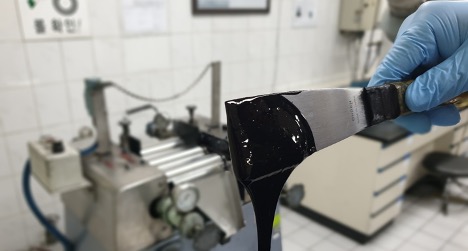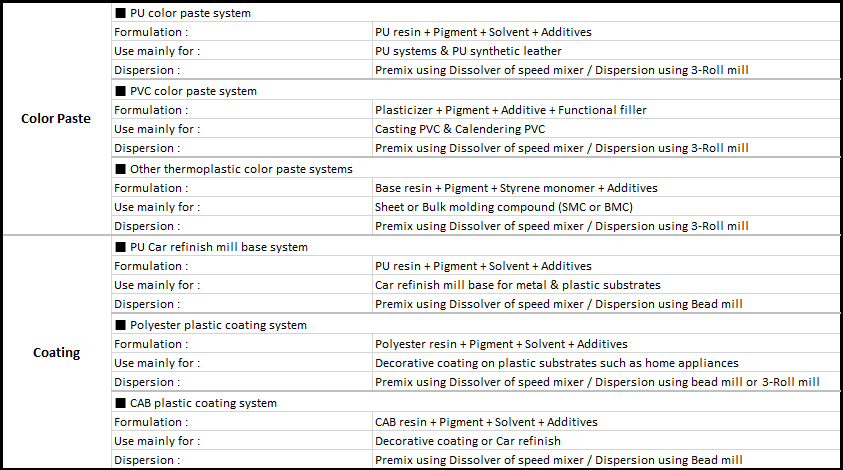BIRLA CARBON BLOG
INSIDER KNOWLEDGE FOR ALL THINGS CARBON BLACK
6 Precautions When Designing Thermoplastic, PVC and Polyurethane Colorant Formulations
08 / 17 / 2021 by Jinil Kim

Reading Time: 4.25 minutes
There are many ways to add color and functionality to your plastic material. Printing, coating and plating methods are used to impart color and functionality to the surface of plastics. Direct dispersion and colorants are used to impart color and functionality to both the interior and exterior of plastic. Among colorants, only color paste has a liquid form, which is different from a master batch or color chip, and follows a similar formulation and dispersion method to coating as shown in the tables below.

Color paste has the advantage that it can be applied in various types of plastic and can perform in more diverse color requirements. However, in order for carbon black color paste to fully demonstrate these benefits, you need to watch out for a few things. Here are 6 precautions and tips you need to know.
Color performance and dispersion
The better the color performance of color paste, the less the amount of colorant used, thereby preventing side effects such as migration. Carbon black with a large surface area tends to increase jetness and tinting power, but it is necessary to select a suitable carbon black and dispersion method in consideration of the balance of dispersibility. It is also important that different batches show the same color. To resolve this problem, it is necessary to pay attention not only to the dispersion of carbon black, but also to the selection of additives that can help with long-term stability.
Compatibility
When selecting color paste raw materials, it is necessary to consider compatibility between the raw materials. First, confirm the polarity and pH of the polymer to be dispersed with carbon black and review the dispersing conditions. For example, when treated carbon black is dispersed in a polymer sensitive to changes in pH, the dispersion and color may be affected by phenomena such as hazing, seeding, shocking, gelling, etc. In addition to the compatibility between the raw materials, the compatibility between the color paste and the polymer (the target of the color paste) should also be considered. To this end, it is important to select the polymer, carbon black, and additives in consideration of compatibility. Finally, it is also important to determine a carbon black loading level that does not adversely affect the compatibility.
Heat resistance
Plastic molding inevitably requires thermal energy and often times the finished product is exposed to heat. Carbon black itself is one of the pigments with the strongest heat resistance, but if the heat resistance of other raw materials used with carbon black in color paste is insufficient, the overall heat resistance of the color paste itself can be deteriorated. Therefore, it is necessary to consider thermal energy not only in the selection of carbon black, but also in the selection of other raw materials in the color paste formulation.
UV resistance
For plastic products used outdoors, it is essential to consider UV resistance. To this end, it is important to use an appropriate amount of UV stabilizer or curing agent that can help to improve UV resistance. It is also important to avoid raw materials that act as photodegradation catalysts, such as TiO2. Carbon black is a representative UV absorber. Carbon black fully dispersed with appropriate resins and additives can provide adequate UV resistance in many cases.
Migration resistance
Bleeding is a phenomenon in which dyes or pigments come out to the plastic surface together with plasticizers or UV stabilizers, which are often used as carriers in color paste. Such bleeding rarely occurs with inorganic pigments such as carbon black. However, migration can happen in plastics using carbon black color paste such that carbon black appears on the surface of the plastic. The migration of carbon black can occur when the carbon black loading in the color paste is high or when large amounts of color paste are used. But most carbon black migration is caused by undispersed carbon black. In order to decrease the migration issue due to undispersed carbon black, it is necessary to review the formulation and dispersion method. It is also worth considering the selection of a more easily dispersible carbon black.
Performance other than Color
In addition to product performance, there is a movement around the world to more safely manage chemical substances. These chemical regulations are being applied with stricter guidelines and with a faster rate of change, especially in food contact, skin contact, semiconductor, and automotive applications. Therefore, it is necessary to check the chemical substance regulations for the color paste and finished products. These regulations should be checked and followed not only for carbon black but also for all the raw materials used.
If you design your color paste with suitable raw materials and mixing methods according to the application needs, you can reduce trial and error and develop a superior product. Birla Carbon application experts are available to help you with your color paste formulation, please contact us to have a detailed discussion.
Since color paste has a high similarity to the formulation/dispersion of coatings, you may want to refer to the know-how of the coating system. I recommend reading Dr. Richard Abbott’s previous blog “Five (Less Obvious) Reasons Your Coatings Formulation Is Not Performing”.

Jinil Kim
Jinil is currently Senior Manager of the Specialty Blacks application laboratory in South Korea and Technical Service, North Asia, for the plastics, inks and coatings markets. He has been working in the coatings industry since 1998 and joined Birla Carbon in 2009. He likes to communicate with customers and enjoys developing solutions to customers’ application problems. He also hopes to support the use of carbon black in a variety of applications. Jinil completed his doctoral course in electrochemistry from the Korea Polytechnic University. He received his Master of Science in industrial chemistry in Inha University and his Bachelor of Science in chemical engineering from Korea Polytechnic University.
WANT TO LEARN MORE ABOUT CARBON BLACK AND THE PROPERTIES THAT MAKE IT IDEAL FOR YOUR PLASTICS, COATINGS, AND INKS APPLICATIONS?










Leave A Comment